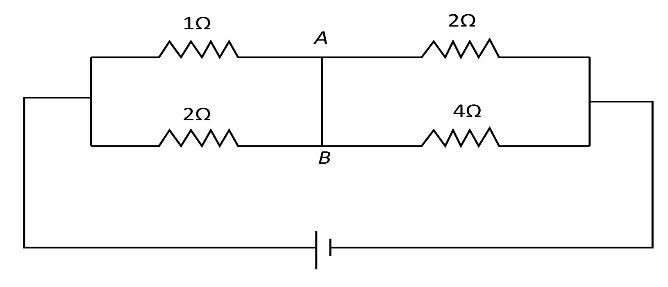
The current flowing through the segment

(A)
(B)
(C)
(D)

Answer
478.5k+ views
Hint: First, we can redraw the circuit diagram so that it is easy to identify the parallel resistances and the resistances in series with each other. We can apply the current divider rule to the circuit to find the solution.
Complete step by step answer:Let us first redraw the given circuit diagram as follows:
Here the points
Let us define
The equivalent resistance of the resistances
Here
Substituting the values for
Again, we can write the equation for the equivalent resistance of the resistances
Here
Substituting the values for
From the circuit diagram we can see that the combination of parallel resistances
Here
Now, we can substitute
Now the total current flowing through the circuit can be written as
Here
Since
Now, using the current divider rule, we can write the equation for the current
Substituting the values for
Again, using the current divider rule, we can write equation for the current
Substituting the values for
Now, the current flowing through the segment
Here
Now substituting the values of
Since, the current obtained has a positive value, we can confirm that the direction of the current is from
Therefore, the option (A) is correct.
Note:It should be noted that the resistances connected between two pints at the same potential difference are in parallel. Similarly, we should also note that the resistances connected between points at different potential differences are in series.
Complete step by step answer:Let us first redraw the given circuit diagram as follows:
Here the points
Let us define
The equivalent resistance of the resistances
Here
Substituting the values for
Again, we can write the equation for the equivalent resistance of the resistances
Here
Substituting the values for
From the circuit diagram we can see that the combination of parallel resistances
Here
Now, we can substitute
Now the total current flowing through the circuit can be written as
Here
Since
Now, using the current divider rule, we can write the equation for the current
Substituting the values for
Again, using the current divider rule, we can write equation for the current
Substituting the values for
Now, the current flowing through the segment
Here
Now substituting the values of
Since, the current obtained has a positive value, we can confirm that the direction of the current is from
Therefore, the option (A) is correct.
Note:It should be noted that the resistances connected between two pints at the same potential difference are in parallel. Similarly, we should also note that the resistances connected between points at different potential differences are in series.
Recently Updated Pages
Master Class 4 Maths: Engaging Questions & Answers for Success

Master Class 4 English: Engaging Questions & Answers for Success

Master Class 4 Science: Engaging Questions & Answers for Success

Class 4 Question and Answer - Your Ultimate Solutions Guide

Master Class 11 Economics: Engaging Questions & Answers for Success

Master Class 11 Business Studies: Engaging Questions & Answers for Success

Trending doubts
Give 10 examples of unisexual and bisexual flowers

Draw a labelled sketch of the human eye class 12 physics CBSE

Differentiate between homogeneous and heterogeneous class 12 chemistry CBSE

a Tabulate the differences in the characteristics of class 12 chemistry CBSE

Why is the cell called the structural and functional class 12 biology CBSE

Differentiate between insitu conservation and exsitu class 12 biology CBSE




